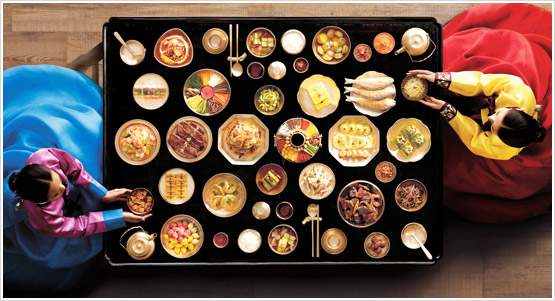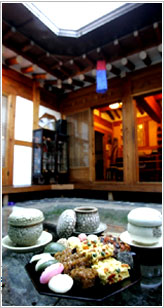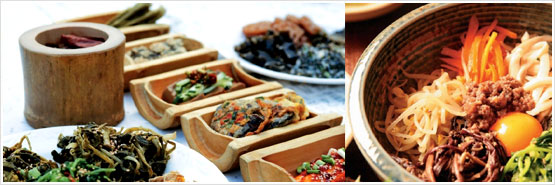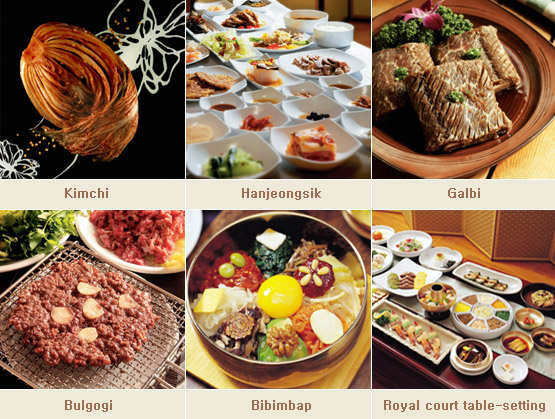 Korean food is referred to in Korean as Hansik. While many other Asian ethnic foods such as Chinese or Japanese food have become popular throughout the world, Korean food has yet to reach its peak. The Korean government is crusading for the globalization of hansik in cooperation with companies, civic groups and the mass media. As the people of the world gain a better understanding of Korean food, its flavors, and its roots, Korean food will undoubtedly become a global commodity like the food of Korea’s neighbors.
Korean food is referred to in Korean as Hansik. While many other Asian ethnic foods such as Chinese or Japanese food have become popular throughout the world, Korean food has yet to reach its peak. The Korean government is crusading for the globalization of hansik in cooperation with companies, civic groups and the mass media. As the people of the world gain a better understanding of Korean food, its flavors, and its roots, Korean food will undoubtedly become a global commodity like the food of Korea’s neighbors. The key to Hansik is fermentation. Every nation has their unique fermented foods such as cheese, yogurt or natto. There are many kinds of fermented foods in Korean cuisine. The purpose of fermentation is to purposely break down foods into more digestible components through the natural use of the bacteria that exists all around us. Unlike food simply going bad, fermentation represents a useful and practical change. So the Korean says not sseokhinda (to be spoiled) but “sakhinda” (to be fermented). The expression is based on the concept of in-depth understanding on fermentation. The quintessential fermented food of hansik is kimchi, and although there are hundreds of different kinds, the most internationally well known is spicy fermented cabbage. When meeting someone who has never encountered kimchi before, Koreans may introduce its as a type of salad, a kind of salad made using spices, red peppers, salt, garlic and oriental cabbage, sauerkraut with a kick, if you will. But this simple explanation leaves out the most important variable, that of fermentation, which is the entire key to how a particular batch of kimchi might taste. The kimchi that is preferred most by Korean people contains salted shrimp or anchovies and has aged underground for at least a year in a jangdokdae (large clay jar). Like a fine wine, the process of aging gives kimchi its deep taste.
The key to Hansik is fermentation. Every nation has their unique fermented foods such as cheese, yogurt or natto. There are many kinds of fermented foods in Korean cuisine. The purpose of fermentation is to purposely break down foods into more digestible components through the natural use of the bacteria that exists all around us. Unlike food simply going bad, fermentation represents a useful and practical change. So the Korean says not sseokhinda (to be spoiled) but “sakhinda” (to be fermented). The expression is based on the concept of in-depth understanding on fermentation. The quintessential fermented food of hansik is kimchi, and although there are hundreds of different kinds, the most internationally well known is spicy fermented cabbage. When meeting someone who has never encountered kimchi before, Koreans may introduce its as a type of salad, a kind of salad made using spices, red peppers, salt, garlic and oriental cabbage, sauerkraut with a kick, if you will. But this simple explanation leaves out the most important variable, that of fermentation, which is the entire key to how a particular batch of kimchi might taste. The kimchi that is preferred most by Korean people contains salted shrimp or anchovies and has aged underground for at least a year in a jangdokdae (large clay jar). Like a fine wine, the process of aging gives kimchi its deep taste. Koreans express a well-aged kimchi as being "ripe". The verb of "ripe' is often used for fruits. However, the Korean use it also for many kinds of fermented food. As with fruit, edible after the process of blooming, growing and ripening on the tree, in the same way, kimchi is allowed to develop its own complexities of taste over a long period of time. The very idea of kimchi embodies the notion of extended waiting.
 Some of the other typical fermented food found Korean table are jang (sauces) of all kinds including ganjang (soybean sauce), gochujang (red pepper paste) and doenjang (soybean paste) are known collectively as jang (sauces). The old saying that the taste of food is the taste of sauce is highly applicable in hansik because these sauces are the basis of Korean food. Sauces are added to most Korean dishes and foods are classified depending on the kinds and quantity of the sauces they contain
Some of the other typical fermented food found Korean table are jang (sauces) of all kinds including ganjang (soybean sauce), gochujang (red pepper paste) and doenjang (soybean paste) are known collectively as jang (sauces). The old saying that the taste of food is the taste of sauce is highly applicable in hansik because these sauces are the basis of Korean food. Sauces are added to most Korean dishes and foods are classified depending on the kinds and quantity of the sauces they contain
Koreans make their supply of kimchi once a year before winter to ensure they get the nutrients they need during the winter. This tradition is known as gimjang. The ‘jang’ in gimjang and ‘jang’ in ganjang, gochujang and doenjang are the same word and reflects the same basic principle of fermentation.
Another feature of hansik is that it is strongly based on vegetables. The basic composition of a table serving is steamed rice, soup and a variety of side dishes. All of them are traditionally vegetable based; in fact, a side dish of meat was typically a rare sight on the dining table of common people. The cow in Korea, which has long been an agricultural society, was regarded as a tool of labor rather than mere food.
Hansik is fundamentally a slow food, a cuisine well suited to health and well being, because it is mostly based on vegetables grown locally and aged and fermented sauces. One of the best opportunities for visitors to Korea is 'the temple stay'. The most popular type of temple stay is one that includes the true temple dining experience, which prohibits the use of meat and of artificial flavors.
As the unique taste and undeniable health benefits of hansik are becoming more widely known, the day is surely not far off where everyone will be able to enjoy hansik at home or at their neighborhood Korean restaurant.
[Major Korean foods]
Source : visitkorea.or.kr




No comments:
Post a Comment